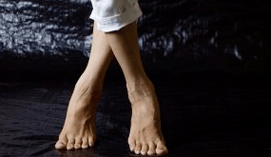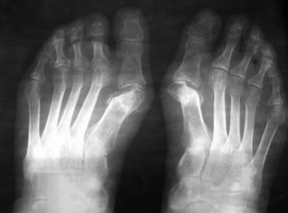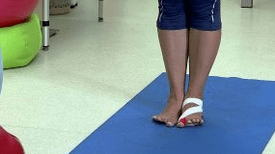Surgical treatment for Valgus deformity is considered an effective method of therapy.This disease is characterized by a pathological change in the shape of the foot, which requires recovery otherwise the complications are possible to damage.The operation is usually performed at 3-4 stages of pathology.

Surgery as an effective method of treatment valgus
Development factors
Valgus deformation of the foot is difficult to determine in the first stages due to asymptomatic.Ballerinas, women who prefer to wear tall spikes, elderly, are located in the formation of such pathology.Such reasons for the formation of Valgus's legs are distinguished:
- diseases of the endocrine system;
- flat legs;
- violation of the ligamentary apparatus;
- limb injuries;
- Heredity.
This disease is classified in such stages of development depending on the degree of lesion:
- The first finger is lower than 20 degrees, displaced until the patient has discomfort.
- The connection is shifted by 30 degrees.The pain is manifested after the loads.
- Shift from 30 to 50 degrees.Feelings of pain of constant nature that do not allow to move normally.
- The joint is shifted more than 50 degrees.Strong deformity of the foot and acute pain.
In children, deformation of valgus may be congenital or acquired.This disease develops against the background of pathologies of the musculoskeletal system.The first signs appear when the child begins to walk.
What is Valgus dangerous?
During the development of such a pathology, a sick person faces the problem of the choice of shoes because the convex bone carries severe discomfort and pain when touching.In addition to aesthetic modifications, the deformation of valgus affects such structures on the foot as ligaments, tendons, bones and compounds.As well as Valgus, the legs are dangerous for the development of such pathologies of the musculoskeletal system:
- Deformation of arthrosis;
- Bursit in chronic form;
- longitudinal transver flat legs;
- the growth of bone structures;
- Complete shift of the plus bone.
Indications for operations in valgus foot

Non -operative treatment for Valgus deformation is performed only by the child until the leg is completely formed.The main indicators of intervention are pain, discomfort, limited motor activity, inflammatory processes, infection, severe visual changes and gait disorder.Flat valgus cloc is only surgically treated.Other methods - gymnastics, orthopedic shoes, stop the development of the pathology.But in 3-4 stages in conservative ways, not to solve the problem.At this stage, the finger deviates from 25-35 degrees, and the plus bone sinks at 18 degrees, which is deformed by the other phalanges.
Types and characteristics of providence
The choice of a certain type of surgery is performed individually depending on the degree of development of the pathology, the condition of the patient and the related diseases of the musculoskeletal system.More often, such types of surgery are used:
- Osteotomy.These are reconstructions.A small incision was made through which Lateatarasophalangeal connection is made.Then the bone growth is eliminated.The removal of bone is performed on an immobilized joint.Osteotomy is performed with the subsequent consolidation of bone fragments using a compression device with titanium.Distinguish the following subspecies: Austin with V- or L-shaped secretion used to display 17 °;Z-shawl with a 17-40 ° shape;Akin (Wedge -hape) - combines with other methods.
- Small -invasive intervention is frugal technique.The blows are made on both sides of the thumb.The surgeon introduces micro-instruments and restores the correct position of the axis of the first finger.The action is controlled by the monitor.This type of surgery is performed by children when no traditional methods of treatment have been given results.
- Arthrodesis is a radical method.Deformation and pain are eliminated, but the relationship becomes stationary.Lack of mobility does not affect a person's gait.The open section removed parts of the proximal head and first plus bone, the remaining fragments are connected to screws, which will subsequently be removed.

Correction of bone position is a complex surgery.Immediately after surgery, the specialist recommends bed rest.Soft tissue swelling is removed with cold compresses.The first 6 weeks of walking are only possible with orthosis, which will remove additional load from the limb.Restoration of ordinary motor activity - after 1.5 months.Rehabilitation takes about six months.The postoperative period (10 days) the patient is in the hospital under the supervision of doctors.In order to speed up the recovery process, the managed limb is important to keep the body in the supine position.Rehabilitation includes massage courses, electrophoresis, exercise therapy and UVT.
Complications
Surgical interventions of such a plan are mainly tolerated at any age.But there are unwanted complications.These include:
- the formation of thrombosis;
- infectious body infections;
- aseptic necrosis;
- limiting the amplitude of the thumb engine;
- Nerve endings injuries;
- allergic manifestations;
- Paresthesia of the fingers.
Forecasts after surgery
If the intervention is done on both legs, it is important to rest for 3-6 months.
If you follow the doctor's recommendations, the forecasts are favorable.Do not charge the working limb with high exercise.After surgery, you should wear orthopedic shoes or special insoles.It is better for women to abandon high heels and tight shoes.Thanks to modern surgery methods, Valgus is subject to complete correction.























